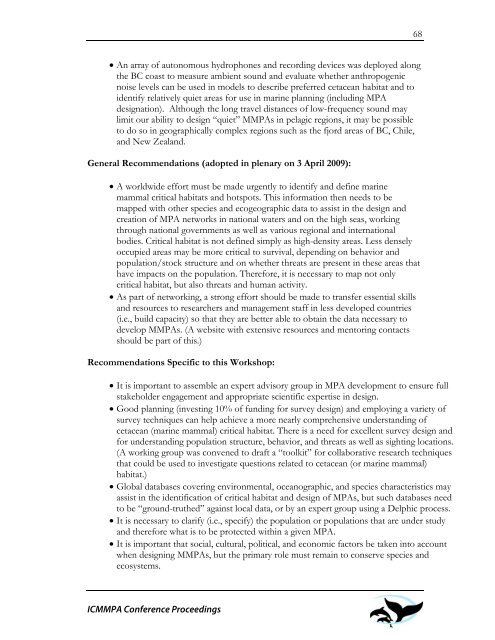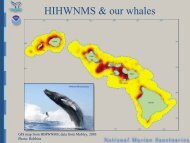The First International Conference on Marine Mammal Protected Areas
The First International Conference on Marine Mammal Protected Areas
The First International Conference on Marine Mammal Protected Areas
You also want an ePaper? Increase the reach of your titles
YUMPU automatically turns print PDFs into web optimized ePapers that Google loves.
• An array of aut<strong>on</strong>omous hydroph<strong>on</strong>es and recording devices was deployed al<strong>on</strong>g<br />
the BC coast to measure ambient sound and evaluate whether anthropogenic<br />
noise levels can be used in models to describe preferred cetacean habitat and to<br />
identify relatively quiet areas for use in marine planning (including MPA<br />
designati<strong>on</strong>). Although the l<strong>on</strong>g travel distances of low-frequency sound may<br />
limit our ability to design “quiet” MMPAs in pelagic regi<strong>on</strong>s, it may be possible<br />
to do so in geographically complex regi<strong>on</strong>s such as the fjord areas of BC, Chile,<br />
and New Zealand.<br />
General Recommendati<strong>on</strong>s (adopted in plenary <strong>on</strong> 3 April 2009):<br />
• A worldwide effort must be made urgently to identify and define marine<br />
mammal critical habitats and hotspots. This informati<strong>on</strong> then needs to be<br />
mapped with other species and ecogeographic data to assist in the design and<br />
creati<strong>on</strong> of MPA networks in nati<strong>on</strong>al waters and <strong>on</strong> the high seas, working<br />
through nati<strong>on</strong>al governments as well as various regi<strong>on</strong>al and internati<strong>on</strong>al<br />
bodies. Critical habitat is not defined simply as high-density areas. Less densely<br />
occupied areas may be more critical to survival, depending <strong>on</strong> behavior and<br />
populati<strong>on</strong>/stock structure and <strong>on</strong> whether threats are present in these areas that<br />
have impacts <strong>on</strong> the populati<strong>on</strong>. <str<strong>on</strong>g>The</str<strong>on</strong>g>refore, it is necessary to map not <strong>on</strong>ly<br />
critical habitat, but also threats and human activity.<br />
• As part of networking, a str<strong>on</strong>g effort should be made to transfer essential skills<br />
and resources to researchers and management staff in less developed countries<br />
(i.e., build capacity) so that they are better able to obtain the data necessary to<br />
develop MMPAs. (A website with extensive resources and mentoring c<strong>on</strong>tacts<br />
should be part of this.)<br />
Recommendati<strong>on</strong>s Specific to this Workshop:<br />
• It is important to assemble an expert advisory group in MPA development to ensure full<br />
stakeholder engagement and appropriate scientific expertise in design.<br />
• Good planning (investing 10% of funding for survey design) and employing a variety of<br />
survey techniques can help achieve a more nearly comprehensive understanding of<br />
cetacean (marine mammal) critical habitat. <str<strong>on</strong>g>The</str<strong>on</strong>g>re is a need for excellent survey design and<br />
for understanding populati<strong>on</strong> structure, behavior, and threats as well as sighting locati<strong>on</strong>s.<br />
(A working group was c<strong>on</strong>vened to draft a “toolkit” for collaborative research techniques<br />
that could be used to investigate questi<strong>on</strong>s related to cetacean (or marine mammal)<br />
habitat.)<br />
• Global databases covering envir<strong>on</strong>mental, oceanographic, and species characteristics may<br />
assist in the identificati<strong>on</strong> of critical habitat and design of MPAs, but such databases need<br />
to be “ground-truthed” against local data, or by an expert group using a Delphic process.<br />
• It is necessary to clarify (i.e., specify) the populati<strong>on</strong> or populati<strong>on</strong>s that are under study<br />
and therefore what is to be protected within a given MPA.<br />
• It is important that social, cultural, political, and ec<strong>on</strong>omic factors be taken into account<br />
when designing MMPAs, but the primary role must remain to c<strong>on</strong>serve species and<br />
ecosystems.<br />
ICMMPA <str<strong>on</strong>g>C<strong>on</strong>ference</str<strong>on</strong>g> Proceedings<br />
68



